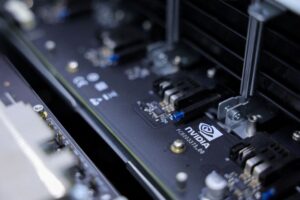Nvidia, a titan in the artificial intelligence chip sector, has reported its slowest revenue growth in seven quarters, sparking a mix of reactions from investors. Following the release of its earnings report, the Santa Clara-based company saw its shares drop by 5%, eventually stabilizing with a 2.5% decline in after-hours trading, closing the regular session down 0.8%.
Over the last two months, Nvidia’s stock surged over 20%, even reaching an intraday record high the previous Monday. Since the start of the year, the stock has nearly quadrupled its value, contributing to a staggering market capitalization of $3.6 trillion. However, the current earnings report has showed signs of a deceleration in growth, as the excitement of previous quarters—where sales often saw over 100% increases—begins to wane.
The Blackwell Family Launch: A Mixed Blessing
Nvidia is in the midst of rolling out its new line of AI chips, known as the Blackwell family. While market enthusiasm for these powerful processors is evident, CFO Colette Kress admitted that initial production will strain gross margins. Initially forecasted to have margins in the low 70% range, these are expected to improve to the mid-70s as production ramps up. A notable highlight is that Nvidia anticipates exceeding initial sales projections for these chips, with estimates of several billion dollars in sales for the fourth quarter.
However, challenges are on the horizon. Reports of overheating issues with a liquid-cooled server containing 72 of the new chips have raised eyebrows. Yet, CEO Jensen Huang has reassured investors that these are isolated issues, emphasizing that high-performance engineering requires resilience and adaptability.
A Slower Growth Forecast
Nvidia’s fourth-quarter revenue guidance ranges from $37.5 billion, with a potential safe margin of 2%, which is above analysts’ expectations of $37.09 billion. Even so, this represents a sharp decline in growth rate, predicted to drop to approximately 69.5% from last quarter’s 94%. While this still signifies remarkable growth in the context of AI’s booming market—especially in data centers—the implications for investors looking for explosive growth might be sobering.
Market strategist Ryan Detrick pointed out that high investor expectations make maintaining impressive earnings growth increasingly challenging. “As they continue to raise the bar, sometimes it’s hard to clear it,” he noted. This cautious outlook comes amidst a broader scramble in the market as firms navigate supply chain difficulties, marking a stark contrast to Nvidia’s previously celebrated performance.
Under the Hood: Supply Chain Hurdles
While Nvidia continues to face demand surges for its AI chips, supply chain bottlenecks are making it difficult to consistently report high revenue beats. The production difficulties largely stem from the constraints at TSMC, Nvidia’s fabrication partner. Huang mentioned that ramping up Blackwell production is crucial and emphasized that efforts are underway to increase production lines and improve yield.
The term "yield" refers to the percentage of functional chips produced from a fabrication process and is critical for overall profitability. Nvidia has reportedly addressed a design flaw with its Blackwell chips. Such iterations indicate a strong commitment to quality and performance, which will be key as the company navigates these engineering challenges.
Earnings Insights: A Silver Lining?
Despite the modest growth forecast, Nvidia’s third-quarter adjusted earnings came in at 81 cents per share, outperforming estimates of 75 cents. The data center division, which accounts for a significant portion of revenue, saw an impressive 112% growth year-over-year, showcasing the insatiable demand from cloud companies as they scale their capabilities to meet the massive computing requirements of AI.
As Nvidia continues to innovate and roll out new products, the company remains a focal point in discussions about the future of AI and data processing. Though investors are managing their expectations, the robust underlying demand for AI chips indicates that Nvidia is poised for sustained growth, albeit at a pace that may not meet the extraordinary benchmarks set in prior years.
In summary, while Nvidia’s latest report shows signs of slower growth, the company’s focus on innovation, addressing supply chain challenges, and responsiveness to market demands will ultimately define its trajectory in this competitive sector. For investors, understanding these dynamics is crucial in making informed decisions about their portfolios in the fast-evolving landscape of AI technology.

